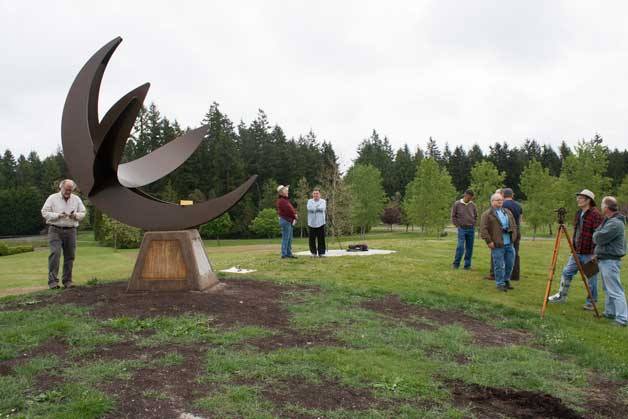Unfortunately, there was no sunshine on a cloudy day during the installation of a long-awaited sundial at Battle Point Park earlier this week.
But, despite the lack of sunshine, the buzz of excitement revolved around the sculpture as it was put in place on Tuesday — nearly six years after the project idea was born. Several Battle Point Astronomical Association members — the group that spearheaded the project — and volunteers were on site to help in calibrating and setting up the equatorial sundial.
In the upcoming weeks, more pieces will be added to complete the dial, including a gnomon and hour plate with numbers to tell the time.
A dedication is set for the last weekend in June, and members anticipate it will be fully finished with informational plaques by late July.
“It’s been a long time coming,” said Steve Ruhl, president of Battle Point Astronomical Association.
“I’m very pleased with it. This is a contribution to the community,” he said. “We’re not always available for people to ask questions. Hopefully this will peak some interest [in our club].”
The base of the sundial was delivered and set a few weeks ago and weighs around 6,000 pounds. The open sphere is estimated to be around 1,600 pounds or so, members said. An equatorial sundial is the simplest sundial to construct and easiest to visualize, according to an Iowa State University Polaris Project website.
While the idea was well-accepted by the parks department, the public and others, the funds were unavailable at the time of the discussion to build one. It took “nickels and pennies” to gather the full amount to even consider creating a sundial, Ruhl said.
For more than five years, the Battle Point Astronomical Association slowly raised $30,000 for the equatorial sundial. Between the support of 120 individual donors, the North American Sundial Society, Bainbridge Community Foundation, Bainbridge Island Parks Foundation and the Seattle Foundation, the sundial project coordinators received the grand total needed to complete the project.
Now, in place, it will last a long time as it is made of steel and is coated with a bronze-colored paint.
“It’s impressive,” said Frank Petrie, sundial project manager. “It’s a very elegant design.”
Petrie noted that it would not have been a success if it weren’t for the donors and help of the Bainbridge Island Metropolitan Park & Recreation District. Those who offered construction services — pro bono — were also a great help to the project, he added.
“A lot of people have come together to make this happen,” he said.
Designed by local artist Bill Baran-Mickle, the sundial is 9 feet across and sets on top of pedestal almost 12 feet off the dial. It sits just north of the Edwin E. Ritchie Observatory inside Battle Point Park.
On Tuesday, Baran-Mickle watched as the engineers and astronomers calibrated the piece he designed so long ago.
While the project process has taken awhile, the designer said the wait was worth it to see it now as the public will in its final stages.
“I like what it is. It’s time. I never needed a digital watch or to read an analog watch. I like the idea that people can wander over here and look at the time,” said Baran-Mickle. “We can slow down, which we don’t get to do very often.”
Baran-Mickle said he often walks the park and knows that the large, unique piece will draw people in once they know about it.
“This is just a wonderful addition to the park, “ he said. “I think it’s warm and welcoming and will bring people in.”
Most of the association’s work takes place at night in the observatory, but the sundial will offer a way for daytime walkers to be a part of the conversation, members said. Plaques at the base of the sundial will explain how it works and other astronomy information once it’s completed.
“This is a major milestone,” Ruhl said of placing the sundial inside the park. “The goal here is to have a very accurate sundial. It’s a work in progress. I think we want it done.”



